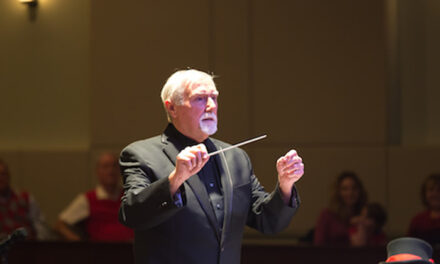In the charming, woodsy seclusion of Wilson Amphitheater, the Snow Camp Historical Drama Society is busy working wonders with a group of enthusiastic volunteers. Now in its 37th season, The Sword of Peace is the Piedmont’s equivalent of The Lost Colony. Playwright William Hardy has masterfully dramatized the true story of the Cane Creek community of peace-loving Friends caught in the bloody violence of the Revolutionary War. The play features colorful characters facing difficult dilemmas — fighting Quakers, drunkards, drill sergeants, and hen-pecked husbands torn between friendship and pride, faith and love.
The play opens with a tableau slowly built of fragments of interaction, introducing Simon (Kyle Travis) and Elizabeth Dixon (Nickie Hilton) in their new home in North Carolina, while the sounds of Copland’s Appalachian Spring paint a complementing musical picture of frontier life. The difficulty of living peacefully in a time of war is developed as the thread of conflict runs through the lives of the major characters. Simon acts as a patriarchic figure, advising others in spite of his own inner struggle. Thomas Hadley (John Martin) eventually makes his most crucial choice in the havoc of the Battle of Guilford Courthouse: squinting down the barrel of his musket at a British Soldier, he is offered the bloody sword of war on one hand and, on the other, the broken sword of peace.
The dichotomy between the ideals of freedom and the carnage of war presented in The Sword of Peace is deeply thought-provoking. Directors Ed Whitehead and R. Scott Rivera walk a careful line between artsy and down-to-earth; the more daring effects, such as a slow-motion flash forward, are tastefully employed and enhance the work without distracting by drawing attention to the craft itself. Various arrangements of “Simple Gifts” provided musical unity, from the opening strains of Appalachian Spring to the candlelit a cappella arrangement at the very end. The opportunities of an outdoor theater are used to advantage: an escapee jumps on a horse and gallops offstage and soldiers simulate plenty of smoky gunfire. Valiant efforts were made by the cast to compete with the relentless cicadas, which, for the most part, were met with success. The fist-fights could look a little more realistic, but the hanging scene was as effective as one could wish — no easy blackout for these folks!
John Martin offered an impassioned, powerful performance as Thomas, and Phillip Wayne Butts made an irresistibly charming ne’er-do-well. Kyle Travis, however, easily stole the hearts of the audience from the moment Simon Dixon strode onstage with the dreams of his new life in his eyes. His transitions from optimistic adventurer to troubled middle age to final illness and death demonstrated his quick adaptability, and his own struggle between war and peace was masterfully portrayed.
One of the most delightful aspects of this production is the unpretentious approach of the cast and crew. Many perform double duty off the stage as well as on; the co-director himself appeared as Lord Cornwallis. The actors also double as ushers (in full costume), and a selection of the cast has formed an a cappella group to provide a little entertainment before each show (they presented several arrangements of old favorites, and while the ensemble could benefit from a bit of polish, it featured several outstanding voices). After two modest full-cast bows, the actors lined the exit and thanked the audience for coming. Whether onstage, offstage, or backstage, those who make The Sword of Peace a reality teach that it is indeed a gift to be simple.











